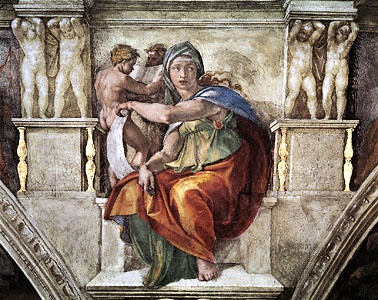Sibyl
Greek legendary figure
also called Sibylla,
 prophetess in Greek legend and literature. Tradition represented her as a woman of prodigious old age uttering predictions in ecstatic frenzy, but she was always a figure of the mythical past, and her prophecies, in Greek hexameters, were handed down in writing. In the 5th and early 4th centuries BC, she was always referred to in the singular; Sibylla was treated as her proper name, and she was apparently located in Asia Minor. From the late 4th century the number of sibyls was multiplied; they were localized traditionally at all the famous oracle centres and elsewhere, particularly in association with Apollo, and were distinguished by individual names, “sibyl” being treated as a title.
prophetess in Greek legend and literature. Tradition represented her as a woman of prodigious old age uttering predictions in ecstatic frenzy, but she was always a figure of the mythical past, and her prophecies, in Greek hexameters, were handed down in writing. In the 5th and early 4th centuries BC, she was always referred to in the singular; Sibylla was treated as her proper name, and she was apparently located in Asia Minor. From the late 4th century the number of sibyls was multiplied; they were localized traditionally at all the famous oracle centres and elsewhere, particularly in association with Apollo, and were distinguished by individual names, “sibyl” being treated as a title.In a legend about the sibyl of Cumae in Italy, she accompanied Aeneas on his journey to the Underworld (Virgil's Aeneid, Book VI). According to Dionysius of Halicarnassus, a famous collection of sibylline prophecies, the Sibylline Books, was offered for sale to Tarquinius (Tarquin) Superbus, the last of the seven kings of Rome, by the Cumaean sibyl. He refused to pay her price, so the sibyl burned six of the books before finally selling him the remaining three at the price she had originally asked for all nine. The books were thereafter kept in the temple of Jupiter on the Capitoline Hill, to be consulted only in emergencies. They were destroyed in the fire of 83 BC.
A Judaean or Babylonian sibyl was credited with writing the Judeo-Christian Sibylline Oracles of which 14 books survive. The sibyl came thus to be regarded by some Christians as a prophetic authority comparable to the Old Testament. On the ceiling of the Sistine Chapel, Michelangelo alternated sibyls and prophets. In the medieval hymn Dies Irae, the sibyl is the equal of David as a prophet.
queen of Jerusalem
French Sibylle
born 1160
died , autumn 1190
queen of the crusader state of Jerusalem (1186–90).
The daughter of Amalric I, Sibyl succeeded to the throne upon the death of her brother, Baldwin IV (1185). Baldwin had intended for the throne to pass directly to Sibyl's son Baldwin V, but Sibyl and her husband, Guy de Lusignan, conspired to seize the throne for themselves, embroiling the kingdom in a disastrous war with Saladin.
- Lucknow Pact
- Lucky Luciano
- Lucky Thompson
- Luc Montagnier
- Lucretia
- Lucretia Crocker
- Lucretia Garfield
- Lucretia Mott
- Lucretia Peabody Hale
- Lucretius
- Lucrezia Borgia
- Lucullus, Lucius Licinius
- Lucy Boston
- Lucy Brewer
- Lucy Burns
- Lucy Fitch Perkins
- Lucy Hay Carlisle, countess of
- Lucy Hay, countess of Carlisle
- Lucy Hayes
- Lucy Hobbs Taylor
- Lucy Jane Rider Meyer
- Lucy Louisa Coues Flower
- Lucy Maud Montgomery
- Lucy Maynard Salmon
- Lucy Minnigerode